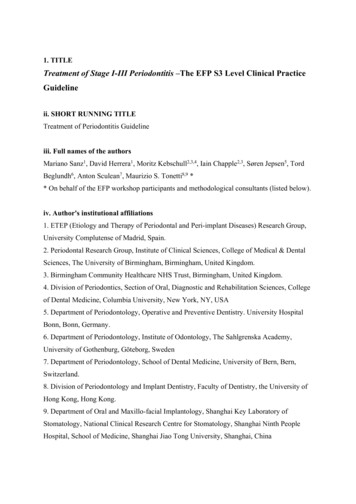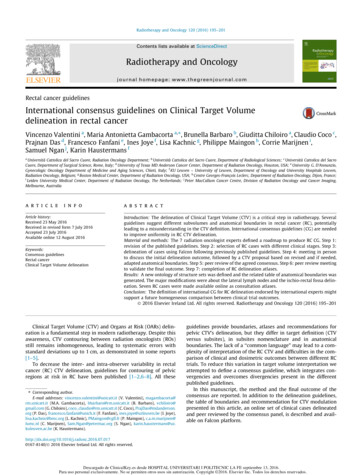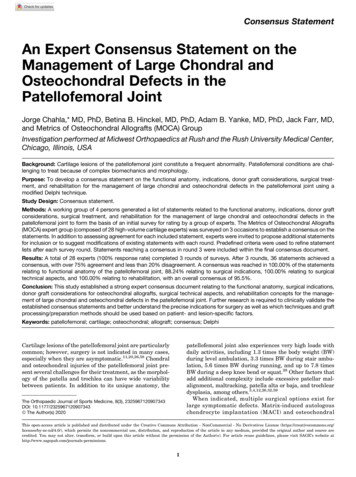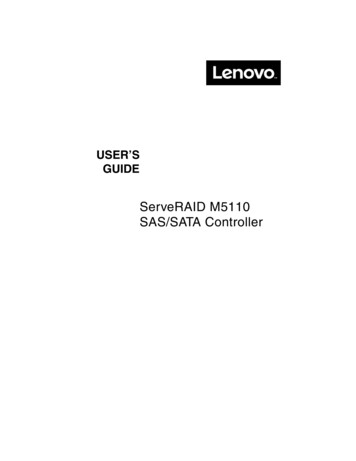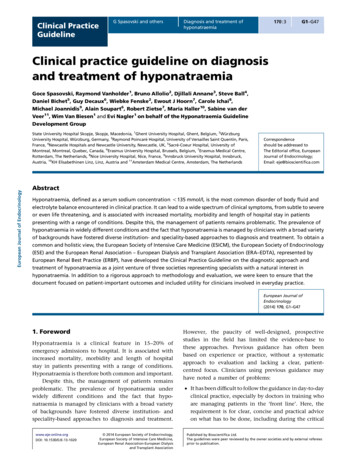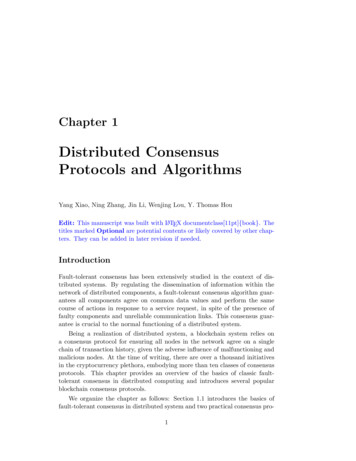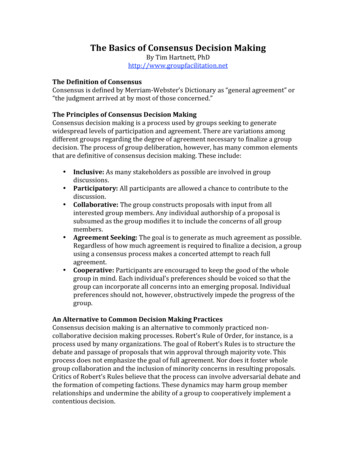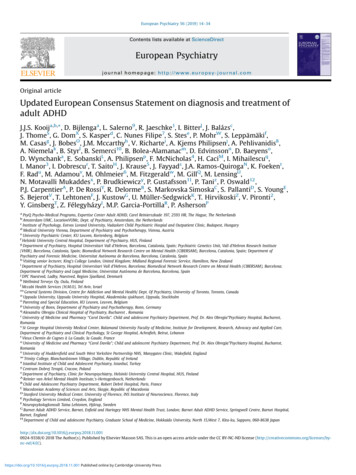
Transcription
European Psychiatry 56 (2019) 14–34Contents lists available at ScienceDirectEuropean Psychiatryjournal homepage: http://www.europsy-journal.comOriginal articleUpdated European Consensus Statement on diagnosis and treatment ofadult ADHDJ.J.S. Kooija,b,* , D. Bijlengaa , L. Salerno9 , R. Jaeschke1, I. BitterJ , J. Balázsc ,J. ThomeS, G. DomX , S. Kasperd, C. Nunes Filipe7, S. Stese, P. MohrW, S. Leppämäkif ,M. Casasg, J. BobesO , J.M. Mccarthyh , V. Richartei, A. Kjems Philipsenj , A. Pehlivanidis8 ,A. Niemelak , B. Styrl , B. Semerci10 , B. Bolea-Alamanacm , D. Edvinssonn , D. Baeyenso ,D. Wynchanka , E. SobanskiL , A. Philipsenp , F. McNicholas4 , H. CaciM , I. Mihailescuq ,I. Manor3 , I. Dobrescur, T. SaitoH , J. Krause5 , J. Fayyads , J.A. Ramos-QuirogaN , K. Foekent ,F. Radu , M. Adamouv, M. Ohlmeier6 , M. Fitzgeraldw, M. GillQ , M. LensingU,N. Motavalli Mukaddesx, P. Brudkiewiczy, P. Gustafsson11, P. Taniz , P. Oswald12 ,P.J. CarpentierA , P. De RossiY, R. DelormeB, S. Markovska SimoskaC , S. PallantiD , S. YoungE ,S. BejerotV , T. LehtonenF, J. KustowG , U. Müller-SedgwickK , T. HirvikoskiZ , V. Pironti2 ,Y. GinsbergT, Z. FélegyházyI , M.P. Garcia-PortillaR , P. AshersonPaPsyQ Psycho-Medical Programs, Expertise Center Adult ADHD, Carel Reinierszkade 197, 2593 HR, The Hague, The NetherlandsAmsterdam UMC, LocationVUMc, Dept. of Psychiatry, Amsterdam, the NetherlandsInstitute of Psychology, Eotvos Lorand University, Vadaskert Child Psychiatric Hospial and Outpatient Clinic, Budapest, HungarydMedical University Vienna, Department of Psychiatry and Psychotherapy, Vienna, AustriaeUniversity Psychiatric Center, KU Leuven, Kortenberg, BelgiumfHelsinki University Central Hospital, Department of Psychiatry, HUS, FinlandgDepartment of Psychiatry, Hospital Universitari Vall d’Hebron, Barcelona, Catalonia, Spain; Psychiatric Genetics Unit, Vall d’Hebron Research Institute(VHIR), Barcelona, Catalonia, Spain; Biomedical Network Research Centre on Mental Health (CIBERSAM), Barcelona, Catalonia, Spain; Department ofPsychiatry and Forensic Medicine, Universitat Autònoma de Barcelona, Barcelona, Catalonia, SpainhVisiting senior lecturer, King’s College London, United Kingdom; Midland Regional Forensic Service, Hamilton, New ZealandiDepartment of Psychiatry, Hospital Universitari Vall d’Hebron, Barcelona; Biomedical Network Research Centre on Mental Health (CIBERSAM), Barcelona;Department of Psychiatry and Legal Medicine, Universitat Autònoma de Barcelona, Barcelona, SpainjDPC Naestved, Ladby, Naestved, Region Sjaelland, DenmarkkWellmind Terveys Oy, Oulu, FinlandlMccabi Health Services (H.M.O), Tel Aviv, IsraelmGeneral Systems Division, Centre for Addiction and Mental Health/ Dept. Of Psychiatry, University of Toronto, Toronto, CanadanUppsala University, Uppsala University Hospital, Akademiska sjukhuset, Uppsala, StockholmoParenting and Special Education, KU Leuven, Leuven, BelgiumpUniversity of Bonn, Department of Psychiatry and Psychotherapy, Bonn, GermanyqAlexandru Obregia Clinical Hospital of Psychiatry, Bucharest , RomaniarUniversity of Medicine and Pharmacy “Carol Davila”. Child and adolescent Psychiatry Department, Prof. Dr. Alex Obregia”Psychiatry Hospital, Bucharest,RomaniasSt George Hospital University Medical Center, Balamand University Faculty of Medicine, Institute for Development, Research, Advocacy and Applied Care,Department of Psychiatry and Clinical Psychology, St George Hospital, Achrafieh, Beirut, LebanontVieux Chemin de Cagnes à La Gaude, la Gaude, FranceuUniversity of Medicine and Pharmacy “Carol Davila”; Child and adolescent Psychiatry Department, Prof. Dr. Alex Obregia”Psychiatry Hospital, Bucharest,RomaniavUniversity of Huddersfield and South West Yorkshire Partnership NHS, Manygates Clinic, Wakefield, EnglandwTrinity College, Blanchardstown Village, Dublin, Republic of IrelandxIstanbul Institute of Child and Adolescent Psychiatry, Istanbul, TurkeyyCentrum Dobrej Terapii, Cracow, PolandzDepartment of Psychiatry, Clinic for Neuropsychiatry, Helsinki University Central Hospital, HUS, FinlandAReinier van Arkel Mental Health Institute,’s-Hertogenbosch, NetherlandsBChild and Adolescent Psychiatry Department, Robert Debré Hospital, Paris, FranceCMacedonian Academy of Sciences and Arts, Skopje, Republic of MacedoniaDStanford University Medical Center, University of Florence, INS Institute of Neuroscience, Florence, ItalyEPsychology Services Limited, Croydon, EnglandFNeuropsykologkonsult Taina Lehtonen, Hjärup, SwedenGBarnet Adult ADHD Service, Barnet, Enfield and Haringey NHS Mental Health Trust, London; Barnet Adult ADHD Service, Springwell Centre, Barnet Hospital,Barnet, EnglandHDepartment of Child and adolescent Psychiatry, Graduate School of Medicine, Hokkaido University, North 15,West 7, Kita-ku, Sapporo, 060-8638 0010924-9338/ 2018 The Author(s). Published by Elsevier Masson SAS. This is an open access article under the CC BY-NC-ND license .https://doi.org/10.1016/j.eurpsy.2018.11.001 Published online by Cambridge University Press
J.J.S. Kooij et al. / European Psychiatry 56 (2019) 14–3415IADHD Központ(center) Budapest, Budapest, HungarySemmelweis University, Department of Psychiatry, Budapest, HungaryAdult ADHD Service, Barnet, Enfield & Haringey NHS Mental Health Trust, North London & Department of Psychiatry, University of Cambridge; Adult ADHDService, Springwell Centre / Barnet Hospital, Barnet, London, EnglandLCentral Institute of Mental Health, Mannheim; University Medical Center Mainz, Mainz, GermanyMHopitaux Pediatriques de Nice CHU Lenval, Nice, FranceNDepartment of Psychiatry, Hospital Universitari Vall d’Hebron, Barcelona, Catalonia, Spain; Psychiatric Genetics Unit, Vall d’Hebron Research Institute(VHIR), Barcelona, Catalonia, Spain; Biomedical Network Research Centre on Mental Health (CIBERSAM), Barcelona, Catalonia, Spain; Department ofPsychiatry and Forensic Medicine, Universitat Autònoma de Barcelona, Barcelona, Catalonia, SpainODepartment of Psychiatry, School of Medicine, University of Oviedo - Centro de Investigación Biomédica and Red de Salud Mental, CIBERSAM, Oviedo, SpainPSGDP Building, Institute of Psychiatry Psychology and Neuroscience, Kings' College London, London, EnglandQDepartment of Psychiatry, Trinity College Dublin, School of Medicine, Dublin, Republic of IrelandRDept. of Psychiatry, University of Oviedo, School of Medicine, Psychiatry, Oviedo, SpainSThome, Klinik und Poliklinik für Psychiatrie und Psychotherapie, Universitatsmedizin Rostock, Rostock, GermanyTStockholm Center for Eating Disorder R&D Unit, Department of Clinical Neuroscience, Karolinska Institutet, Stockholm, SwedenUOslo University Hospital, Department of Rare Disorders, NevSom - Norwegian Centre of Expertise for Neurodevelopmental Disorders and Hypersomnias,Oslo, NorwayVÖrebro Univerity, School of Medical Sciences, Campus USÖ, Örebro, SwedenWNational Institute of Mental Health, Klecany, Czech Republic; Third Faculty of Medicine, Charles University Prague, Czech RepublicXAntwerp University (UA, CAPRI), Boechout, BelgiumYDepartment of Neurology and Psychiatry, Sapienza University of Rome, Rome; Department NSMOS, Faculty of Medicine and Psychology, University“Sapienza”of Rome, Rome, ItalyZCenter for Neurodevelopmental Disorders at Karolinska Institutet (KIND), CAP Research Center, Stockholm, Sweden1Jagiellonian University Medical College, Section of Affective Disorders, Department of Psychiatry, Krakow, Poland2Cambridge Adult ADHD & ASD Clinic, Cambridge, England3Geha MHC, Petach-Tikva, Israel4University College Dublin, Dublin, Republic of Ireland5Outpatient Clinic, Ottobrunn, Germany6Klinikum Kassel, Department of Psychiatry and Psychotherapy, Kassel, Germany7Nova Medical School. Universidade NOVA Lisboa, Lisboa, Portugal8National and Kapodistrian University of Athens Medical School, Eginition Hospital, Department of Psychiatry, Athens, Greece9INS, Institute of Neuroscience, Florence, Italy10Hasan Kalyoncu University, Poyracık Sokak. Istanbul, Turkey11Lund University, Clinical Sciences Lund, Child and Adolescent Psychiatry, Lund, Sweden12High Security Hospital, CRP Les Marronniers, Tournai, BelgiumJKA R T I C L E I N F OA B S T R A C TArticle history:Received 9 July 2018Received in revised form 2 November 2018Accepted 3 November 2018Available online 16 November 2018Background Attention-deficit/hyperactivity disorder (ADHD) is among the most common psychiatricdisorders of childhood that often persists into adulthood and old age. Yet ADHD is currentlyunderdiagnosed and undertreated in many European countries, leading to chronicity of symptoms andimpairment, due to lack of, or ineffective treatment, and higher costs of illness.Neurodevelopmental DisordersMethods The European Network Adult ADHD and the Section forAcross the Lifespan (NDAL) of the European Psychiatric Association (EPA), aim to increase awareness andknowledge of adult ADHD in and outside Europe. This Updated European Consensus Statement aims tosupport clinicians with research evidence and clinical experience from 63 experts of European and othercountries in which ADHD in adults is recognized and treated.Results Besides reviewing the latest research on prevalence, persistence, genetics and neurobiology ofADHD, three major questions are addressed: (1) What is the clinical picture of ADHD in adults? (2) Howshould ADHD be properly diagnosed in adults? (3) How should adult ADHDbe effectively treated?Conclusions ADHD often presents as a lifelong impairing condition. The stigma surrounding ADHD,mainly due to lack of knowledge, increases the suffering of patients. Education on the lifespanperspective, diagnostic assessment, and treatment of ADHD must increase for students of general andmental health, and for psychiatry professionals. Instruments for screening and diagnosis of ADHD inadults are available, as are effective evidence-based treatments for ADHD and its negative outcomes.More research is needed on gender differences, and in older adults with ADHD. 2018 The Author(s). Published by Elsevier Masson SAS. This is an open access article under the CC BYNC-ND license ).Keywords:Adult ADHDUpdated European Consensus StatementDiagnosisTreatmentEuropean Network Adult ADHDEPA1. Introduction: the European Network Adult ADHDThe European Network Adult ADHD (ENAA) was founded in2003 to help improve the diagnosis and treatment of ADHD inadults in Europe and beyond. ENAA represents mental health careprofessionals and researchers from 28 countries with expertise ion Neurodevelopmental Disorders Across the Lifespan (NDAL)of the European Psychiatric Association (EPA) joined our effort to* Corresponding author at: European Network Adult ADHD, VUMc, Amsterdam,EPA, The Netherlands.E-mail address: s.kooij@psyq.nl (J.J.S. 1 Published online by Cambridge University Pressprovide this update of our first Consensus Statement on adultADHD published in 2010 [1].1.1. Objectives of the updated consensus statement for cliniciansDespite strong evidence on the clinical presentation, genetics,neurobiology, the burden of the disorder, and on safe and effectivetreatment for ADHD in adults, many people are still underdiagnosed and undertreated. Specialized clinical services remainscarce in most parts of the world, including Europe [2,3]. Our aim isto provide an update of the literature on assessment and treatmentof adult ADHD to [1] increase awareness on ADHD as an impairinglife-long neurodevelopmental condition up to old age [2]; update
16J.J.S. Kooij et al. / European Psychiatry 56 (2019) 14–34the assessment procedure for diagnosing ADHD in adults; and [3]give updated recommendations for appropriate treatments.1.2. MethodologyCreating a Consensus Statement does not follow the sameprocedure as required for the development of a guideline, suchas systematic reviews using formal ratings of the evidence.Most of the authors participated in the development of a firstConsensus Statement on adult ADHD in 2010, and were askedto provide an update of the previous text based on new findingsin the literature since the time of publication. Subgroupsdealing with different subjects were formed. The subgroupsreached consensus on the text among themselves beforesending it to the first author. The first author put all paragraphstogether and edited the text with the help of a few othercoauthors (DW, SY, PA, DB). This draft of the manuscript wassend to all authors for their comments. The first authorchecked the comments and implemented adjustments into thetext, and send the final version to all authors for agreement. Allauthors agreed with the final version.2. Heritability and environmentFamily, twin and adoption studies from the last 20 years showthat ADHD is a familial disorder with high heritability, indicatingthat a significant genetic component influences risk for thedisorder [4–12]. Environmental factors such as severe institutionaldeprivation are also likely to play a role, either as main causalfactors in a few cases [13] or by interaction with genetic risks.Family studies indicate a risk to first-degree relatives of 4–5 foldthe population rate or higher, with prevalence rates around 20%among first degree relatives [14]. Data on ADHD in children andadolescents find average heritability of around 76% [12]. Studies inadult twins using self-rated ADHD symptoms consistently reportlower estimates of heritability, around 30–40% [15–17]. One reasonfor lower heritability of adult self-reported ADHD symptoms maybe from the use of self-ratings. These lead to lower estimates ofheritability compared to informant ratings regardless of age,perhaps due to variable levels of awareness among individualsrating their own ADHD symptoms [18,19]. Studies combining dataacross informants [20], or using clinical diagnostic information[21] find heritability estimates for adult ADHD in the same range(70–80%) as for children [22].2.1. Candidate genesEarly molecular genetic studies of ADHD in children reportedgenetic associations with several candidate genes. Genetic variantswithin or near the D4 and D5 dopamine receptor genes providedthe most consistent findings supported by meta-analysis [23].Other specific candidate genes were implicated in the early studies[12,24,25], but none have provided consistent evidence or beenreplicated in more recent large-scale genome wide associationstudies. Taken together the traditional neurotransmitter systemgenes appear to explain only a small amount of the variance inADHD [26]. There is also some converging evidence for the role ofgenes that fit into a neurodevelopmental network involved indirected neurite outgrowth [27].2.2. Genome wide association studies (GWAS)More recent findings have emerged from genome-wideassociation studies [28]. The most recent dataset reported includedover 20,000 ADHD cases and 35,000 controls. These data were usedto estimate that around 30% of the heritability of ADHD ishttps://doi.org/10.1016/j.eurpsy.2018.11.001 Published online by Cambridge University Pressexplained by common genetic variation. In total, twelve lociachieved genome-wide significance, including FOXP2; notablebecause prior work had implicated it in adult ADHD [29]. Thesefindings place ADHD firmly on the path to detecting very largenumbers of associated common genetic variants as more samplesare accrued.LD regression analyses that estimate genetic correlationsbetween disorders find strong genetic links between ADHD anda range of outcomes including educational performance, depression, obesity, smoking and lung cancer [28]. A further finding is thevery strong genetic correlation between the diagnosis of ADHD,and trait scores in general population samples, demonstrating thatADHD represent the extreme of a continuously distributed trait inthe general population [30]. These finding confirm the polygenicnature of genetic liability to ADHD.Rare copy number variants (CNVs) occurring on less than 1% ofchromosomes are also known to play a role in a subset of individualswith ADHD [31,32]. CNVs were found to be 2-fold more common inchildren with ADHD within the normal IQ range, and 6-fold higher inthose with IQs below 70 [32]. Specific genes suggested as CNVslinked to ADHD include the nicotinic alpha-7 acetylcholine receptorgene (e.g., [33]), several glutamate receptor genes [34] andneuropeptide-Y [35], although these findings remain inconsistentand hard to verify due to low frequency in the population.2.3. Molecular genetic studies of adult ADHDMolecular genetic studies of adult ADHD are less advanced, butare expected to confirm some genetic associations identified inchildhood and find other genetic associations related to persistence or remission of ADHD in adult life [20]. A preliminary reportat the International Neuropsychology meeting (Washington, 2018)found the genetic correlation between child and adult ADHD to begreater than 80%. Most of the current research has beencoordinated in Europe by Barbara Franke from the Netherlandsfor the International Multicentre Persistent ADHD Collaboration(IMPACT) group. This collaboration has successfully generated amulti-site sample of more than 3500 patients and continues togrow. To date several publications highlight potential associationswith adult ADHD, some but not all of which are shared with geneticassociation findings in children [36–42].2.4. Environmental factorsIt has been known for a long time that environmental factorsare associated with ADHD [43], particularly prenatal risk factorssuch as exposure to alcohol and drugs, valproic acid, high bloodpressure, maternal stress during pregnancy, as well as pretermbirth and low birth weight [44–46]. However sophisticatedstudy designs are needed to clarify whether these associationreflect direct effects of the environmental exposure or reflectgenetically correlated risk measures. For example, althoughsmoking during pregnancy is clearly associated with offspringADHD, this association appears to be entirely accounted for bythe genetic correlation between maternal smoking and offspring ADHD [47]. In contrast, evidence from Romanianadoptees suggests that severe early deprivation is causallyrelated to ADHD in a dose dependent way [13]. Gene byenvironment interactions (G x E) have been proposed and mayexplain some of the missing heritability seen betweenheritability estimates derived from twin (0.76) and moleculargenetic (0.22) data. However, to date no G x E effects have beenclearly identified. The findings to date indicate that much morework is needed to understand the interplay between geneticand environmental risks.
J.J.S. Kooij et al. / European Psychiatry 56 (2019) 14–343. Neurobiology of ADHD3.1. Neuro-imaging: evidence for atypical gray and white matter areasStructural brain scans of adults with ADHD showed grey matterabnormalities in several brain areas, including the right frontal andprefrontal areas [48,49], anterior cingulate [50–52], the basalganglia and the cerebellum [53–56] with some preliminaryresearch also showing abnormalities of the visual cortex [57].Additionally, cortical thickness was found to be reduced in adultADHD [56,58,59]. Some evidence suggests that grey matterabnormalities, in some subcortical regions, are more pronouncedin children than adults. This might reflect the effects of age,medication, intrinsic heterogeneity of the ADHD syndrome, or acombination thereof [51,60–64].Despite these reported findings the latest mega-analysisconducted by the Enigma consortium found no significantdifferences in brain structure between adult ADHD and controls;although, small but significant differences were found in childrenfor subcortical regions including the accumbens, amygdala,caudate, hippocampus, putamen and intracranial volume witheffects ranging from d .10–.15 [65]. These findings indicate thatwhile there are structural changes in subcortical brain regions inADHD in children, these are relatively subtle effects that dissipatewith increasing age.Diffusion tensor imaging (DTI) highlighted that white mattertracts, including fronto-occipital, fronto-striatal, temporal andtemporo-occipital fasciculi and part of the corpus callosum, bearmicrostructural abnormalities [66–71]. Additionally, some findings also linked microstructure variability to symptomatology suchthat greater inattention but not hyperactivity-impulsivity wasassociated with significantly lower fractional anisotropy (that islower microstructural integrity) in the left uncinate and inferiorfronto-occipital fasciculi compared to controls [70]. These resultsindicate that structural deficits in ADHD are not just confined tospecific regions but involve interconnections among large scalebrain networks [68,71–73].3.2. Functional neuroimagingRegarding functional MRI (fMRI) studies, task-based andresting-state findings converge. Meta-analyses show that ADHDis associated with dysfunctions in several domain-specific frontostriatal and fronto-cerebellar neural networks. Thus a metaanalysis of 39 child and 16 adult ADHD fMRI studies concluded thatin ADHD there are significant dysfunctions in multiple neuronalsystems involved in higher-level cognitive functions [74]. Theseinclude hypoactivations in the frontoparietal executive controlnetwork, putamen, and ventral attention network, which isconsistent with the classical model of ADHD as a disorder ofdeficient fronto-striatal activation.Hyperactivations are also seen in regions of the default modeand visual networks, which support the contemporary view thatADHD is associated with faulty regulation of relationships betweendefault mode and task positive networks. Similar findings comefrom meta-analyses, which show consistent underactivation ininferior fronto-striatal networks during cognitive tasks [75], indorsolateral fronto-striato-parietal networks during attentiontasks [75], and in fronto-cerebellar networks for timing functions[76]; in addition to abnormally enhanced activation in defaultmode regions [76].The recent focus on resting state fMRI (RS-fMRI) identifiedmultiple intrinsic neural circuits, reflecting functional connectivitywithin and between regions which is continuously encoded in thespontaneous activity of the brain [77]. The intrinsic fronto-parietal,dorsal attentional, visual, motor and default mode networks allhttps://doi.org/10.1016/j.eurpsy.2018.11.001 Published online by Cambridge University Press17overlap with regions showing differential task activations duringinhibition, attention, or working memory tasks in ADHD comparedto controls [78]. Despite the wealth of established findings fromfMRI and RS-fMRI studies of ADHD, cross-sectional neuroimagingdata is correlational in nature and causal inferences cannot yet bemade.More recently outcome studies of children diagnosed withADHD has been able to compare functional brain change in adultswith persistent and remitted ADHD and compare these to agematched controls. The largest such follow-up study to date, of 205children with ADHD, found that persistence of ADHD wasassociated with loss of the balance of connections within thedefault mode network, and connections between the default modeand those supporting attention and cognitive control. In contrastthere were no differences in these networks between those whoseADHD had remitted and non-ADHD controls [79].Overall, despite the wealth of established findings from fMRI andRS-fMRI studies of ADHD, cross-sectional neuroimaging data iscorrelational in nature and causal inferences cannot yet be made. Thefinding that certain functional brain changes are seen to differbetween persistent compared to remitted cases of childhood ADHDsheds some light on likely causal processes, but further longitudinaldata is still required before firm conclusions can be drawn.3.3. Neuropsychological and electrophysiological testsAs a group, individuals with ADHD are characterized by alteredneuropsychological functioning across a variety of executivefunction (EF) measures. However, thus far there is neither aneurobiological nor a neuropsychological test (battery) for ADHDwith sufficient positive predictive power to establish the diagnosisat the individual level [80]. In one study, the vast majority ofneuropsychological instruments showed poor discriminativeability compared to clinical assessment measures such as theASRS Screener v1.1 and the DIVA 2.0 Diagnostic Interview forADHD in adults, with an overall classification accuracy rangingfrom 53% to 66% [81]. Nevertheless, when used in combinationwith the DIVA 2.0, objective cognitive performance tests measuring omission and commission errors, and physical activity, werefound to increase the correct classification of adult ADHD [81].There is currently insufficient evidence to warrant the use ofneuropsychological testing to determine the diagnosis of ADHD[82] or to predict impairment in major life domains [83].Moreover, clinicians should also be aware of the possibility thata few individuals may feign ADHD symptoms to gain externalincentives, like stimulant medication or special academic accommodations. There is some evidence supporting the effectiveness ofperformance validity tests (PVTs) in differentiating betweengenuine and feigned ADHD compared to rating scales [84].Electrophysiological studies suggest that brain dysfunctions areinvolved in the central components of ADHD in both children andadults [85–89], although the finding of increased DAT densityremains controversial [90,91].Data from Electro Encephalography (EEG) is relatively scarce inadult ADHD. Generally, EEG studies of ADHD find similar deficits inadults and children, while some findings change with age andmight be sensitive to developmental changes [92]. Despite US Foodand Drug Administration approval of an EEG device (2013) thatassists in the diagnosis of ADHD subtypes [93–95], this remainscontroversial [96]. EEG tests are not sufficiently accurate but couldbe useful to increase diagnostic certainty.4. ICD and DSM criteria for ADHDThere are two diagnostic manuals used to diagnose ADHD: TheDiagnostic and Statistical Manual of Mental Disorders (DSM) and
18J.J.S. Kooij et al. / European Psychiatry 56 (2019) 14–34the International Statistical Classification of Diseases and RelatedHealth Problems (ICD). As ADHD has been recognized as a disorderaffecting individuals across the lifespan, the diagnostic criteria foradolescents and adults have been adjusted in the DSM-5,published in May 2013:1) ADHD is now in the chapter Neurodevelopmental Disorders,which includes conditions associated with factors affecting thebrain development.2) Diagnostic criteria have been adapted by adding some examplesdescribing how ADHD symptoms are expressed across thelifespan.3) The age of onset criteria has been changed requiring severalsymptoms to be present before age of 12 years, instead of somesymptoms and impairment by age 7.4) The term “subtype” has been replaced by “presentation”,reflecting the variation of ADHD symptoms within the sameindividual during the lifespan.5) The symptom threshold required has been reduced to 5symptoms instead of six for older adolescents and adults( 17 years) in either the inattention or hyperactive/impulsivedomain.6) Criteria requiring significant impairment has been modified to“clear evidence that symptoms interfere with or reduce thequality of social, academic and occupational functioning”, withspecifiers regarding severity level.7) The presence of Autism Spectrum Disorder (ASD) is no longer anexclusion criterion, consistent with evidence showing theirfrequent co-occurrence.8) ADHD Not Otherwise Specified (NOS) has been changed intoOther Specified ADHD and Unspecified ADHD.The revision of ICD-10, ICD-11 has been published in June 2018.ICD-11, developed by the World Health Organization now refers toADHD as Attention Deficit Hyperactivity Disorder, instead ofpreviously Hyperkinetic Disorder (HKD) [97]. It now uses similarrequirements as the DSM-5 regarding age of onset, and the same 3presentation types. In Europe, ICD codes are often used forstatistics on mortality, morbidity and by insurance agencies forhealth-related reimbursements [98], whereas DSM is primarilyused in clinical practice by licensed mental health care professionals [99].The diagnostic assessment starts by evaluation of self-reportedsymptomatology. The clinical interview is essential for diagnosingADHD in adults, which investigates the characteristic symptomsand impairments of ADHD in both childhood and adulthood. Inchildren and adolescents, informants’ ratings are higher correlatedwith heritability and cognitive and EEG findings than self-ratings[19]. Also prevalence and persistence rates increase when parentreports are used [19]. In adults this may be slightly different, assome research shows that the adult patient is the best informant[100]. The presence of a family member however (a parent and/orthe partner) during the assessment can still provide valuableadditional information, e.g. on severity and its translation intodaily activities.There is compelling evidence that a cut-off of four currentsymptoms is the most appropriate for an adult diagnosis [101,102].However, due to concern about the possibility of an artificialincrease in the prevalence of the disorder, DSM-5 lowered thethreshold for diagnosing ADHD from six to five symptoms for thoseolder than 17 years of age. Several items have been expanded bysome illustrative examples to facilitate the recognition of thedisorder throughout development. Although not included inthecriteria as such, behaviors reflecting executive dysfunctionusually appear clearly during the assessment, when patientsdescribe problems with organization, facing daily 2018.11.001 Published online by Cambridge University Presssolving problems, managing time and self-regulating (inh
of Psychology, Eotvos Lorand University, Vadaskert Child Psychiatric Hospial and Outpatient Clinic, Budapest, Hungary . and Forensic Medicine, Universitat Autònoma de Barcelona, Barcelona, Catalonia, Spain . Klinik und Poliklinik für Psychiatrie und Psychotherapie, Universitatsmedizin Rostock, Rostock, Germany

